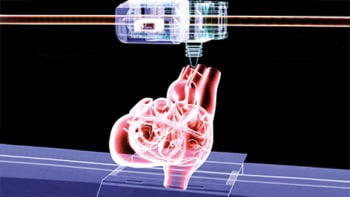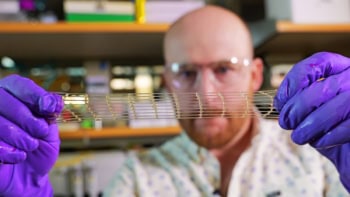
Biologic scaffolds — processed tissues from which the cells have been removed — are finding their place in regenerative medicine. Since they preserve the original extracellular matrix of the tissue, biologic scaffolds promote cell attachment and proliferation, enhancing tissue regeneration. Consequently, there is considerable research underway to study their use in different clinical areas.
Biologic scaffolds are also employed in tumour treatments, where tumour resection requires healing of tissue voids. However, it was unclear whether their use had a negative or positive effect on tumour re-growth. To investigate this issue, a research team led by Jennifer Elisseeff at John Hopkins School of Medicine implanted a biologic scaffold together with cancer cell lines in mice and studied the response. They found that the immune environment created by the scaffold impaired tumour growth (Sci. Transl. Med. 10.1126/scitranslmed.aat7973).
Triggering a specific immune response
The researchers tested a porcine urinary bladder matrix (UBM), a biologic scaffold that is approved by the US Food and Drug Administration for wound healing applications. They mixed particles of UBM with melanoma, colon or breast cancer cell lines and subsequently injected them in mice. In all cases, tumour growth decreased and animal survival increased, compared with injection of the cells alone. Since these scaffolds did not have any cytotoxic effect on the cells, the researchers inferred that the biologic scaffold was triggering an immune response that impaired tumour growth.
The team’s next step was to find out more about this specific immune response. Employing genetically modified immunodeficient mice, the researchers identified CD4 T cells (also called T helper cells, responsible for adaptative immunity) and macrophages as playing the main role in tumour growth inhibition.
Furthermore, they also identified the immune cells’ specific phenotype, and found that it was different to that normally observed in immune cells associated with tumours. In addition, this immune response was completely opposite to that observed with synthetic immune adjuvant materials (such as aluminium hydroxide and silica particles), confirming the uniqueness of the immune response produced by the UBM.
Synergy with immunotherapy
Finally, the researchers combined the UBM with immunotherapy (immune checkpoint inhibitors PD-1, PD-L1 and PD-L2). Such treatments activate the immune system against tumours and could amplify the growth inhibition from UBM.

Indeed, combining UBM with PD-1 or PD-L1 noticeably slowed down tumour growth and increased mice survival. This finding points to the potential of using this biologic scaffold in combination with immunotherapy for tumour treatment.
The team concluded that the immune response generated by the UBM has a pro-healing character that inhibits tumour growth. In addition, such impairment in cancer proliferation can amplify the effect of immunotherapy. However, despite these remarkable results, the researchers point out that biologic scaffolds are complex materials that differ in composition and source, and therefore the findings of this project may not be applicable to all biologic scaffold types. Nevertheless, this study sets a precedent for the use of biologic scaffolds in the treatment of different cancers.



